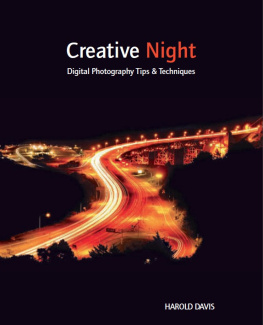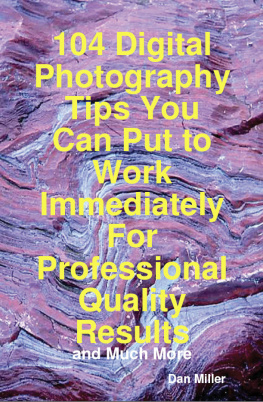Contents
Guide

CONTENTS
HOW TO USE THIS EBOOK
Select one of the chapters from the and you will be taken straight to that chapter.
Look out for linked text (which is in blue) throughout the ebook that you can select to help you navigate between related sections.
You can double tap images and tables to increase their size. To return to the original view, just tap the cross in the top left-hand corner of the screen.
INTRODUCTION
Imagine standing on the edge of a cliff in a remote area, overlooking the ocean on a clear, moonless night. The Milky Way is so bright that it reflects in the ocean, and the way it shoots up into the sky lines up with the small cove in front of you. Its so dark you can barely see your camera in front of you when its LCD isnt lit up, and the crashing waves below are providing a great sonic backdrop to the experience.
I have been fascinated with the night sky ever since I was a kid, and I never get tired of scenes like this. Whether youre on the coast, in the desert, or in the mountains, viewing the night sky in a dark location is always incredible.
I remember seeing the Milky Way for the first time while lying down in a canoe on a lake in Maine, angling for catfish. In that moment, and ever since then, I was amazed by what it was possible to see in the night sky in the right location.
So its fitting that I find myself, as an adult, regularly out in the middle of the night, in the middle of nowhere, taking pictures of the night sky over wilderness, lighthouses, or whatever looks promising. This type of photography is known as landscape astrophotography, and with modern digital cameras and lenses it is much easier to capture these images than ever before. Even an entry-level DSLR or a mirrorless interchangeable-lens camera with a kit lens will capture great images of the night sky.
It does take some practice, and standing around in the dark while your camera takes long-exposure images requires patience, but the results will make you glad you stayed up all night. Landscape astrophotography is one of the most rewarding types of photography that Ive personally experienced. I still get excited when I see the Milky Way pop out on the image review on the LCD of my camera.
This book focuses on capturing pinpoint stars where the stars appear as small, sharp points of light in the sky. The aim of this book is to show you how to achieve this while minimizing the level of noise (digital artifacts) in your images and simultaneously getting your entire scene well exposed and in focus. These are the main challenges to overcome in this type of landscape astrophotography and well look at different techniques for capturing dramatic, high-quality images of the night sky.
We wont touch on star trails or moon photography, although we will briefly cover photographing the aurora and how this differs from capturing just the stars. A much longer book would be needed to cover every aspect of landscape astrophotography.
At the end of this book you should be able to head out into the night with your camera gear and capture the exposures needed to create photographs that are in focus from the foreground to the stars, with little noise. You will also learn how to plan photos ahead of time and how to scout locations during the day in order to make it easier to find your composition in the dark.

The Milky Way and Mars (the bright orb on the left) reflect in the Atlantic Ocean on the rugged coast of Maine.
Nikon Z 7 with Mount Adapter FTZ and Nikon 14-24mm f/2.8 lens at 14mm and f/2.8. Like most of my landscape astrophotographs, this is a blend of multiple exposures for dynamic range and depth of field so that the image has detail, low noise, and is in focus from the foreground to the stars.
Sky: Ten shots each at ISO 6400 and 10 seconds that were star stacked for pinpoint stars and low noise.
Foreground: Focus and exposure stack of three shots, each at f/2.8 and ISO 1600, two exposures at 10 minutes and one exposure at 20 minutes.
1 OVERVIEW OF TECHNIQUES
Landscape astrophotography, by nature, involves very low light levels that make it difficult to get a scene well exposed and in focus from the foreground to the stars in a single exposure without intoducing noise and star trails. To overcome this, multiple exposures are taken which are then blended together and stacked to create a final image.

Milky Way over the Tablelands in Newfoundland, Canada.
1.1TECHNIQUES FOR LOW LIGHT
Using longer shutter speeds or widening your aperture are the obvious ways to let in more light. However, the longer the shutter is open, the more movement it will capture, and widening the aperture means that less of the scene will be in focus. Instead, we can use the following techniques to mitigate these issues.













